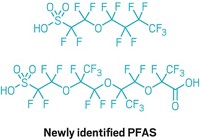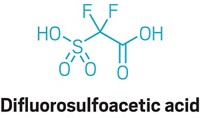Advertisement
Grab your lab coat. Let's get started
Welcome!
Welcome!
Create an account below to get 6 C&EN articles per month, receive newsletters and more - all free.
It seems this is your first time logging in online. Please enter the following information to continue.
As an ACS member you automatically get access to this site. All we need is few more details to create your reading experience.
Not you? Sign in with a different account.
Not you? Sign in with a different account.
ERROR 1
ERROR 1
ERROR 2
ERROR 2
ERROR 2
ERROR 2
ERROR 2
Password and Confirm password must match.
If you have an ACS member number, please enter it here so we can link this account to your membership. (optional)
ERROR 2
ACS values your privacy. By submitting your information, you are gaining access to C&EN and subscribing to our weekly newsletter. We use the information you provide to make your reading experience better, and we will never sell your data to third party members.
Policy
It’s not the mass spectrometer they asked for
Request for mass spectrometer by North Carolina agency meets with a political twist
by Cheryl Hogue
August 25, 2019
| A version of this story appeared in
Volume 97, Issue 33

An expensive scientific instrument usually isn’t a political target, at least not beyond the laboratory. But in North Carolina, a recent state agency’s request for a mass spectrometer was met with significant pushback by industry. After a political fight over the machine, the agency now has equipment it didn’t ask for and that won’t help ferret out emerging contaminants in drinking water, including as-yet-unidentified per- and polyfluoroalkyl substances (PFAS).
North Carolina is a hot spot for novel PFAS tainting water, air, and soil. In recent years, academic and federal scientists have identified previously unrecognized PFAS in the state’s Cape Fear River downstream of a Chemours plant outside Fayetteville. The chemicals, which include by-products from the manufacture of Chemours’s Nafion ionic polymers, are also in the blood of hundreds of people who drank public drinking water drawn from the river. Membranes made of Nafion are used in fuel cells and in industrial applications such as chlor-alkali production.
To look further for unidentified pollutants in drinking-water supplies, the state’s Department of Environmental Quality (DEQ) in early 2018 asked the North Carolina General Assembly for funds to purchase a laboratory instrument familiar to most chemists and many other scientists: a mass spectrometer.
Specifically, the DEQ asked for a high-resolution mass spectrometer.
These instruments can spit out molecular weights of unknown compounds to three or four decimal places, explains Susan D. Richardson, a chemistry professor at the University of South Carolina and a mass spec expert. Richardson, whose research focuses on identifying new disinfection by-products in drinking water and how pharmaceuticals and antibacterial chemicals transform in the environment, is not involved in the situation in North Carolina.
While the data from a high-resolution mass spec provide a molecular formula for an unknown chemical, turning that information into a chemical structure is a puzzle that chemists must solve. “That’s the fun part,” says Richardson, who teaches graduate students to operate mass spectrometers and apply the data they generate—for example, to the identification of unknown chemicals.
In January 2018, DEQ secretary Michael S. Regan laid out the rationale behind the department’s request for a high-resolution mass spec.
“North Carolinians expect DEQ to ensure their water is safe and we need the tools to do our job,” he said in a statement. “This equipment will help DEQ scientists perform the type of in-depth analysis that’s now expected as part of the overall evaluation of water quality in North Carolina.”
A high-resolution mass spectrometer would let the state agency use an investigative method called nontargeted analysis to look for both known and unknown chemicals in water samples, allowing the discovery of new contaminants. In the more traditional method of targeted analysis, scientists look only for specific, known compounds.
Researchers can’t determine the full extent of PFAS contamination in waterways or aquifers using targeted analysis, according to a slew of scientific studies cited in a recent paper on measuring total PFAS in water. “Many precursors, degradation/transformation products, and other PFASs with no analytical standards are ignored” with targeted methods, conclude researchers at the Colorado School of Mines and Brown University who authored the paper (Curr. Opin. Environ. Sci. Health 2018, DOI: 10.1016/j.coesh.2018.08.005).
The DEQ has relied on laboratories of the US Environmental Protection Agency to analyze water samples for PFAS. The EPA’s labs don’t charge for such services, though their turnaround times are much slower than those of private contractors. But these federal labs serve many states, “and their ability to assist North Carolina could end at any time,” the DEQ said in January 2018. In addition, budget cuts proposed by the Trump administration could soon limit the EPA’s ability to conduct nontargeted analyses without charging states.
The loss of the EPA’s analytical services would force the DEQ to contract with private labs to continue North Carolina’s research on and response to emerging contaminants, the agency stated. The DEQ estimated the cost of using lab contractors to be $615,000 per year, which is higher than the purchase prices of most types of mass spectrometers, including high-resolution ones, chemist Richardson says.
North Carolina’s House of Representatives agreed to the DEQ’s request when it passed a budget bill in January 2018. But when the legislation reached the state Senate, political winds shifted.
Senate leader Phil Berger (R) sharply criticized the measure for a variety of reasons. In part, he said in a statement, the legislation would authorize “the purchase of expensive equipment that the state can already access for free.”
The EPA aside, the North Carolina DEQ could run nontargeted analysis of environmental samples such as water and soil for free at the National High Magnetic Field Laboratory in Florida. The National Science Foundation and the State of Florida fund the lab, which boasts the highest-resolution mass spectrometer available. The DEQ would have to submit a proposal to request time to use one of the spectrometers, and once approved, the agency would have to pay only for DEQ staff time, travel, and lodging, Richardson says. First-time users of the facility can apply for support to cover these expenses, she adds.
After Berger spoke out against funding the requested mass spec, political deliberations continued. The North Carolina Manufacturers Alliance, a lobbying group that includes Chemours and other businesses, reached out to lawmakers. The industry organization was specifically worried about the DEQ possessing an analytical instrument that can identify unknown pollutants.
“High-resolution analysis will most assuredly reveal that there are many, many chemicals, pharmaceuticals, and other consumer products” in the state’s water supplies, the industry group’s president, A. Preston Howard Jr., wrote to the legislature in a May 2018 letter. The letter was obtained and posted online by television station WRAL in Raleigh, North Carolina.
Most of the substances “will be detected at very low levels,” Howard said. “There will be very little information about the toxicity of those substances,” which would result in controversies over whether the concentrations found pose significant risk to the public health or the environment, he added.
Howard urged lawmakers to keep the DEQ aimed solely on PFAS. “Expanding North Carolina’s focus to all emerging contaminants will put our state out-of-step with the emerging contaminants work being undertaken in other states, as they are focusing their resources almost exclusively on [PFAS] only.” This would make North Carolina less attractive to new industry, Howard argued.
Regulatory agencies in some other states, especially those grappling with contamination by a suite of PFAS, have high-resolution mass specs they are applying to identify additional PFAS. For instance, a lab in the Minnesota Department of Health has such instrumentation to run nontargeted analyses, state officials tell C&EN. Minnesota is home to the headquarters of 3M and facilities where the company formerly manufactured perfluorooctanoic acid and perfluorooctanesulfonic acid. Regulatory agencies in some other states, including the Washington State Department of Ecology and the New Jersey Department of Environmental Protection, pay contractors for nontargeted mass spectrometry for emerging contaminants, sources with those agencies say.
In North Carolina, the General Assembly ended up appropriating $537,000 for the DEQ for the purchase of a mass spec. That amount was plenty to cover the cost of a high-resolution instrument, according to Richardson. A triple quadrupole mass spec costs about $350,000, depending on the type of features it comes with, Richardson estimates. A high-resolution time-of-flight instrument can run $350,000 to $400,000. An Orbitrap extended-mass-range model costs anywhere from about $400,000 to $800,000, she says. Fourier transform ion cyclotron resonance mass spectrometers are complex instruments that are very accurate, require expensive superconducting magnets, and can cost millions. It’s unclear which of these the DEQ sought to obtain.
Although the North Carolina lawmakers gave the DEQ the money to buy a mass spec, they chose the type of instrument and limited what DEQ scientists can do with it. The legislation mandates that the DEQ spend the money to purchase a triple quadrupole instrument to be used for “targeted analysis of water samples related to discharges of PFAS.”
Gov. Roy Cooper (D) vetoed the legislation. The Republican-controlled General Assembly overrode his veto and enacted the bill into law. Meanwhile, the legislature also provided money to North Carolina universities to test for PFAS in municipal and county drinking-water systems across the state.
The DEQ confirmed to C&EN that it purchased a triple quadrupole mass spectrometer, as directed by law, and installed it in March.
The legislators’ actions frustrated many North Carolina residents who have a variety of PFAS in their drinking-water supplies or their blood. “It’s disheartening that they put that kind of muzzle on DEQ,” says Emily Donovan, cofounder of Clean Cape Fear, an alliance of advocacy groups, community leaders, and others who are seeking clean water in the river. Most varieties of PFAS found in North Carolina water were detected through nontargeted analysis, she points out.
Notwithstanding North Carolina legislators’ foray into mass spectrometer purchasing, scientists interested in studying PFAS appear to be increasingly interested in nontargeted analysis, as evidenced at talks and posters presented earlier this month at a Society of Environmental Toxicology and Chemistry conference dedicated to this class of thousands of compounds. At the meeting, Mark Strynar, an EPA researcher who led a team that first found novel PFAS in the Cape Fear River, encouraged other scientists to look broadly for these compounds in the environment via nontargeted investigations with high-resolution spectroscopy.
“You miss a lot if you don’t have that capability,” he said.





Join the conversation
Contact the reporter
Submit a Letter to the Editor for publication
Engage with us on Twitter